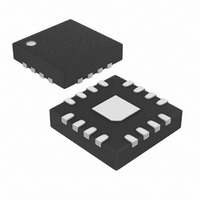MAX6966ATE+ Maxim Integrated Products, MAX6966ATE+ Datasheet - Page 9

MAX6966ATE+
Manufacturer Part Number
MAX6966ATE+
Description
IC LED DRIVER LINEAR 16-TQFN
Manufacturer
Maxim Integrated Products
Type
Linear (Serial Interface)r
Datasheet
1.MAX6966ATE.pdf
(29 pages)
Specifications of MAX6966ATE+
Constant Current
Yes
Topology
Open Drain, PWM
Number Of Outputs
10
Internal Driver
Yes
Type - Primary
Backlight
Type - Secondary
RGB, White LED
Frequency
270kHz ~ 450kHz
Voltage - Supply
2.25 V ~ 3.6 V
Voltage - Output
7V
Mounting Type
Surface Mount
Package / Case
16-TQFN Exposed Pad
Operating Temperature
-40°C ~ 125°C
Current - Output / Channel
20mA
Internal Switch(s)
Yes
Number Of Segments
10
Low Level Output Current
21100 uA
Operating Supply Voltage
2.25 V to 3.6 V
Maximum Supply Current
4 mA
Maximum Power Dissipation
1176 mW
Maximum Operating Temperature
+ 125 C
Mounting Style
SMD/SMT
Minimum Operating Temperature
- 40 C
Lead Free Status / RoHS Status
Lead free / RoHS Compliant
Efficiency
-
Lead Free Status / Rohs Status
Lead free / RoHS Compliant
If a port is changed from static logic low (0x00) or static
logic high (0x01) to a constant-current value
(0x02–0xFE) in shutdown mode, then that output is
automatically turned off (logic high, or high impedance)
like any other constant-current outputs that are dis-
abled in shutdown. When shutdown mode is exited, the
new constant-current output starts just like any other
constant-current outputs.
If a port is changed from a constant-current value
(0x02–0xFE) to static logic low (0x00) or static logic
high (0x01) in shutdown mode, then that output is
instantly set to that value as a GPIO output. When shut-
down mode is exited, the new GPIO output is unaffect-
ed just like any other GPIO outputs.
The MAX6966/MAX6967 can be configured so that a
relatively long pulse on the CS input brings the driver
out of shutdown, as an alternative method to the normal
method of writing the configuration register through the
serial interface. When the CS run option is enabled, a
minimum pulse on CS sets the run bit in the configura-
tion register, bringing the driver out of shutdown and
activating any preconfigured ramp-up. Also, the SPI
interface must be operated at a minimum data rate to
ensure that a normal active-low CS pulse during a 16-
bit regular data transmission is not mistaken for a CS
run command.
The CS run timing uses the PWM clock, which is either
the internal nominal 32kHz oscillator or a user-provided
clock fed into the dual-use DOUT/OSC pin (see the PWM
Clock section for details on configuring the PWM clock).
The minimum pulse on CS to trigger CS run and bring
the driver out of shutdown is 256 to 257 periods of the
PWM clock. For the internal oscillator, this time is 257 /
27000 = 9.52ms. For the external PWM clock, this time
is 257 / OSC and has a shortest possible time of
2.57ms when OSC is set to the maximum allowed
100kHz frequency.
10-Port Constant-Current LED Drivers and I/O
_______________________________________________________________________________________
Expanders with PWM Intensity Control
CS Run Option
The maximum pulse on CS to ensure that CS run is not
triggered (when enabled) is 255 periods of the PWM
clock. For the internal oscillator, this time is 255 / 45000
= 5.66ms. Since a transmission on the serial interface
comprises 16 clocks with CS low, a minimum 2.83kHz
SCLK frequency ensures that CS run is not triggered.
For the external PWM clock, this time is 255 / OSC and
has a shortest time of 2.55ms when OSC is set to the
maximum allowed frequency of 100kHz.
The SPI serial interface circuitry is independent of the
CS run circuitry. Activity on SCLK and DIN is ignored
by the CS run circuitry. A slow SPI transmission to the
MAX6966/MAX6967 can therefore be used as both a
valid data transmission (read or write), and as a means
for exiting shutdown. The CS run action (i.e., setting the
run bit in the configuration register) occurs before any
coincident data transmission is processed. This means
that a slow transmission containing a write command to
the configuration register clearing the run bit would
work, since the write command is implemented internal-
ly after the CS run action that sets the run bit.
The "slow transmission" cut-off data rate is expected to
be lower than the SPI interface speed in the majority of
applications. If this is not the case, the CS run option
can still be used. Consider the situation when the
MAX6966/MAX6967 have been put into shutdown with
the CS run option enabled. The application uses the
MAX6966/MAX6967 with some ports configured as
logic inputs or outputs, which need to be accessed in
shutdown. The SPI interface speed is slow, so any
transmission brings the MAX6966/MAX6967 out of shut-
down. So, how are the I/O ports accessed in shut-
down? The solution is to write the configuration register
disabling CS run (bit D1 = 0) and invoking shutdown
(bit D0 = 0) as the first command. Now any other regis-
ters can be accessed while the MAX6966/MAX6967
remain in shutdown. Finally, write the configuration reg-
ister reenabling CS run (bit D1 = 1) and invoking shut-
down (bit D0 = 0) to restore the original status.
9












